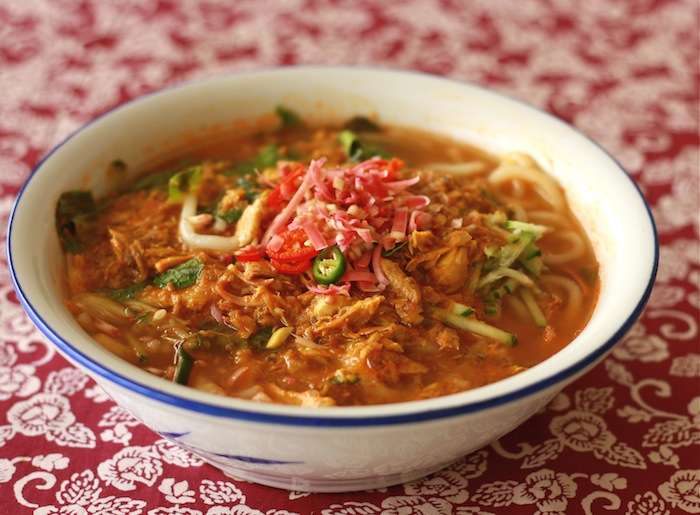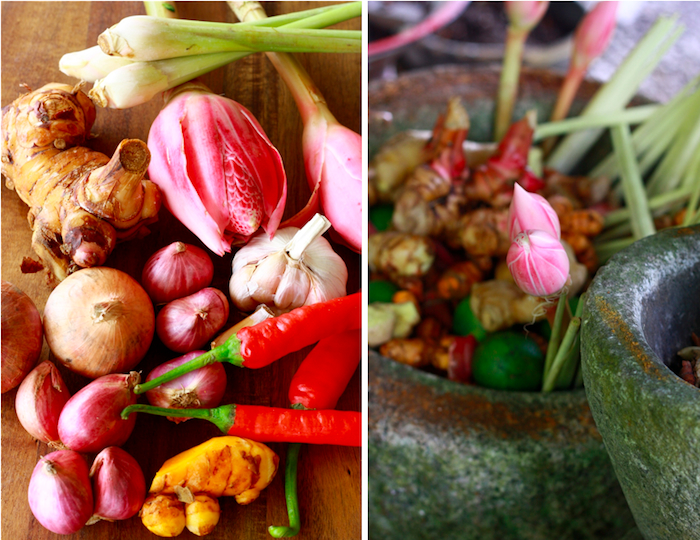After sitting back to read through the “Story of Penang Asam Laksa”, it’s now time to work. Don’t worry, this asam laksa recipe is passed down from my mom, who learned from my grandma, who probably learned from my great-grandma, so it’s been tasted, authenticated, and loved by four Malaysian cooks.
But since my mom has burned her tastebuds from a steady diet of chilies her entire life, and tends to cook most dishes a bit too spicy these days, I cut down her chili amount, so as not to mask the other flavours.
Chili, galangal (lengkuas), lemongrass, fresh turmeric, shallots, garlic, and torch ginger flower (bunga kantan) - the building blocks of asam laksa.
Typically, hawker stalls use local mackerel (ikan kembong) in asam laksa because the low quality fish is the cheapest at the market. When cooking at home, try a better quality fish such as horse mackerel (ikan selar kuning), fresh sardine, or what was used in this recipe – yellowtail kingfish (ikan pelata).
Into boiling water, add the chunks of galangal, lemongrass, and torch ginger flower, along with the cleaned, whole fish. Let boil until the fish is cooked. Then remove the fish, and set aside to cool before breaking off the meat. Or if you have a pair of iron hands like my mom, you can start straight away.
To the soup base, add in fresh Vietnamese mint (otherwise referred to as laksa leaf or daum kesum), for its citrusy aroma. Some dried shrimp paste (belacan) for depth and pungency. And then the essential souring agents for the soup - tamarind pulp and dried tamarind peel (asam keping).
And finally, place the fish flakes back into the broth, and add in the ground spice paste. Let it simmer for an hour, until the flavours fuse and intensify.
Last, fill a bowl with laksa noodles/thick rice noodles, pour in the soup, and garnish with sliced cucumber, pineapples, onions, mint leaves, chilies and torch ginger flower. Add calamansi lime and a spoonful of sweetened dark prawn paste (heh ko sauce) on the side.
A Penang iconic dish synonymous with its home - multifaceted, chaotic, soulful, intimidating, and colorful.

Penang Asam Laksa Recipe by Season with Spice
serves 7 - 8
Ingredients
1 kg pre-cooked laksa noodles (or thick round rice noodles)
Ground spice paste
15 fresh red chilies and 10 dried red chilies (or 3 tbsp freshly ground chili paste)
10 shallots
6 cloves garlic
1 inch of galangal (lengkuas)
2 cm knob of fresh turmeric
2 stalks lemongrass, minced (use the white part only)
1 1/2 tbsp belacan (dried shrimp paste), or if in block form, use 3/4 of a block
Soup
For cooking fish:
15 cups water
3 stalks lemongrass, lightly smashed (white part only)
1 torch ginger flower, quartered
3 inches of galangal, halved
1 1/2 kg (about 15 fish) fresh mackerel, horse mackerel, fresh sardine, or yellowtail kingfish - cleaned and gutted
1/3 cup tamarind juice (mix tamarind pulp in hot water for five minutes before squeezing it to obtain the juice)
5 pieces tamarind peel (asam keping or asam gelugor)
6 stalks Vietnamese mint (daun kesom)
3 tbsp sugar or to taste
Salt to taste
Garnishing
1 cucumber, thinly sliced into strips
Chinese lettuce, sliced
1/2 medium size fresh pineapple, sliced into small pieces
2 red onions, thinly sliced
Handful of mint leaves (daun pudina)
1 torch ginger bud (bunga kantan), finely sliced
3 red chilies, thinly sliced
2 green bird's eye chilies, thinly sliced
Condiments:
Calamansi lime
Sweetened prawn paste (heh ko sauce), diluted with laksa soup or water
Process:
1. Blend spice paste ingredients into a fine paste.
2. Heat a pot of water and add lemongrass, galangal, torch ginger flower. Bring to a boil and then add fish. Boil on medium heat for 15-20 minutes or until the fish is cooked.
3. Transfer cooked fish to a bowl and let cool. Strain broth to remove spices. Add to the broth the Vietnamese mint, tamarind juice and tamarind peel and continue to boil on low heat.
4. Break the fish meat into tiny pieces, but keep some in bigger chunks.
5. Add the fish flakes back into the pot, along with the spice paste.
6. When it reaches a boil, reduce heat and simmer for 40 minutes to one hour. While simmering, add salt and sugar to balance the spiciness and sourness for your taste.
7. Rinse laksa noodles in cold water and strain. Place one serving of noodles into a bowl, and pour laksa soup with fish flakes over the top.
8. Top with garnishing, and serve with a spoonful of shrimp paste if you like.
Enjoy the five tastes – sweet, sour, bitter, salty, umami – of Penang Asam Laksa!
Notes:
1. If you prefer your asam laksa soup to be less sour, cut down on the tamarind peel or tamarind pulp. If you like it to be spicy, add more chili to your spice paste. For a more pungent flavour, use more shrimp paste (belacan and heh koh).
2. Hawker stalls tend to use low quality local mackerel (ikan kembong) in asam laksa. When making the dish at home, you can use a better quality fish like horse mackerel (ikan selar kuning), fresh sardine, or yellowtail kingfish (ikan pelata).
serves 7 - 8
Ingredients
1 kg pre-cooked laksa noodles (or thick round rice noodles)
Ground spice paste
15 fresh red chilies and 10 dried red chilies (or 3 tbsp freshly ground chili paste)
10 shallots
6 cloves garlic
1 inch of galangal (lengkuas)
2 cm knob of fresh turmeric
2 stalks lemongrass, minced (use the white part only)
1 1/2 tbsp belacan (dried shrimp paste), or if in block form, use 3/4 of a block
Soup
For cooking fish:
15 cups water
3 stalks lemongrass, lightly smashed (white part only)
1 torch ginger flower, quartered
3 inches of galangal, halved
1 1/2 kg (about 15 fish) fresh mackerel, horse mackerel, fresh sardine, or yellowtail kingfish - cleaned and gutted
1/3 cup tamarind juice (mix tamarind pulp in hot water for five minutes before squeezing it to obtain the juice)
5 pieces tamarind peel (asam keping or asam gelugor)
6 stalks Vietnamese mint (daun kesom)
3 tbsp sugar or to taste
Salt to taste
Garnishing
1 cucumber, thinly sliced into strips
Chinese lettuce, sliced
1/2 medium size fresh pineapple, sliced into small pieces
2 red onions, thinly sliced
Handful of mint leaves (daun pudina)
1 torch ginger bud (bunga kantan), finely sliced
3 red chilies, thinly sliced
2 green bird's eye chilies, thinly sliced
Condiments:
Calamansi lime
Sweetened prawn paste (heh ko sauce), diluted with laksa soup or water
Process:
1. Blend spice paste ingredients into a fine paste.
2. Heat a pot of water and add lemongrass, galangal, torch ginger flower. Bring to a boil and then add fish. Boil on medium heat for 15-20 minutes or until the fish is cooked.
3. Transfer cooked fish to a bowl and let cool. Strain broth to remove spices. Add to the broth the Vietnamese mint, tamarind juice and tamarind peel and continue to boil on low heat.
4. Break the fish meat into tiny pieces, but keep some in bigger chunks.
5. Add the fish flakes back into the pot, along with the spice paste.
6. When it reaches a boil, reduce heat and simmer for 40 minutes to one hour. While simmering, add salt and sugar to balance the spiciness and sourness for your taste.
7. Rinse laksa noodles in cold water and strain. Place one serving of noodles into a bowl, and pour laksa soup with fish flakes over the top.
8. Top with garnishing, and serve with a spoonful of shrimp paste if you like.
Enjoy the five tastes – sweet, sour, bitter, salty, umami – of Penang Asam Laksa!
Notes:
1. If you prefer your asam laksa soup to be less sour, cut down on the tamarind peel or tamarind pulp. If you like it to be spicy, add more chili to your spice paste. For a more pungent flavour, use more shrimp paste (belacan and heh koh).
2. Hawker stalls tend to use low quality local mackerel (ikan kembong) in asam laksa. When making the dish at home, you can use a better quality fish like horse mackerel (ikan selar kuning), fresh sardine, or yellowtail kingfish (ikan pelata).
Keep the leftover laksa soup for the next day, and fry up some crispy spring rolls (or buy them) and dip it into the soup to enjoy a Penang tradition!







